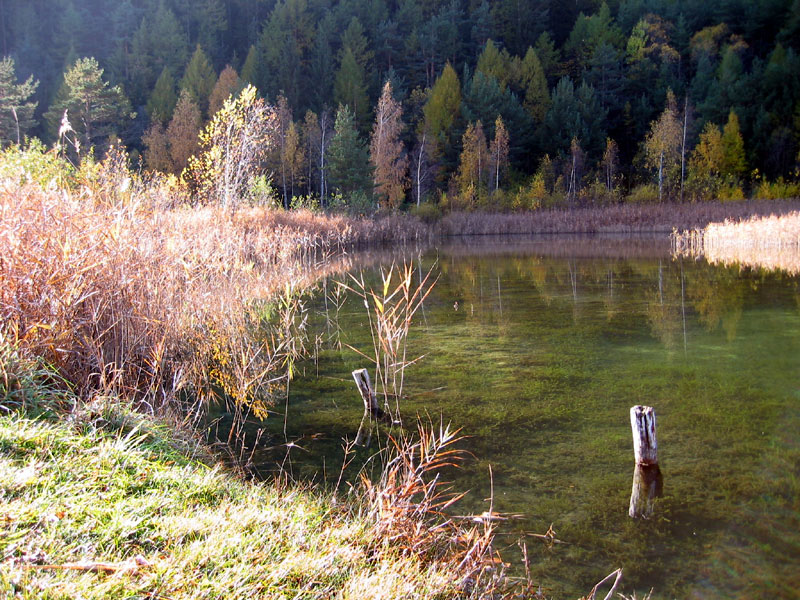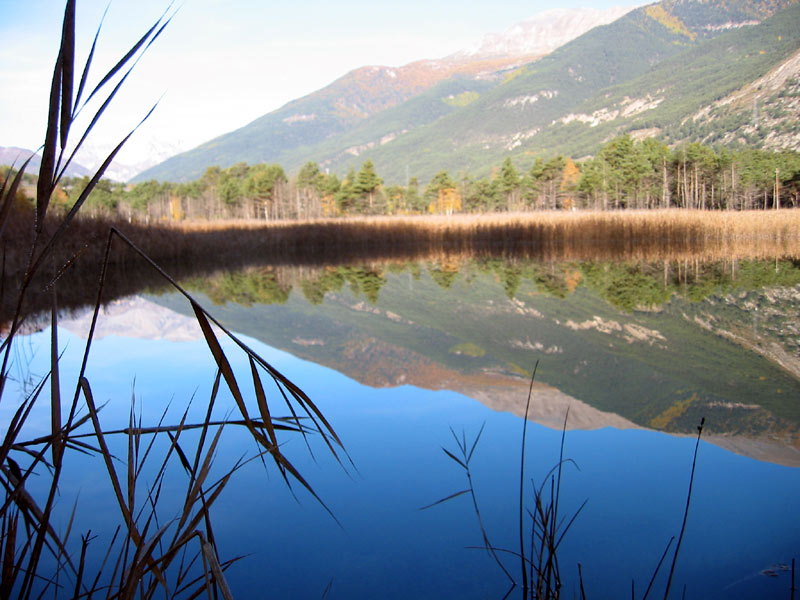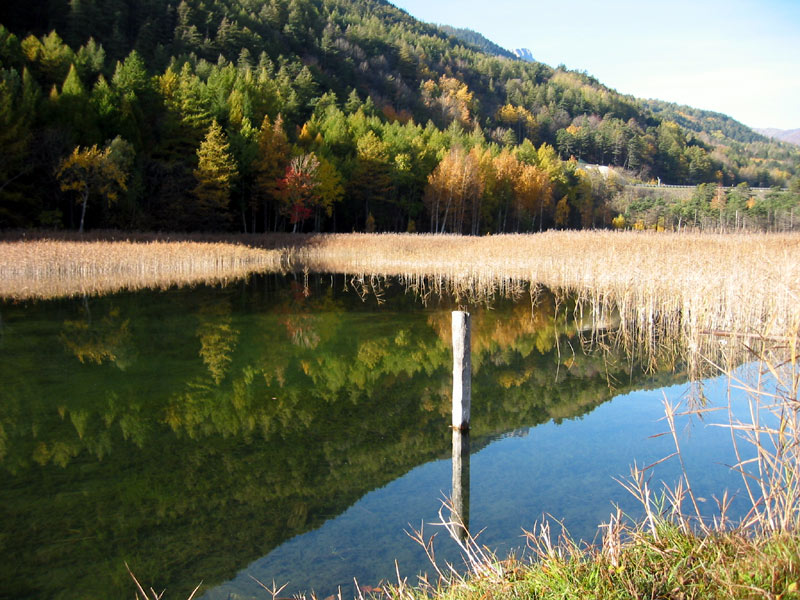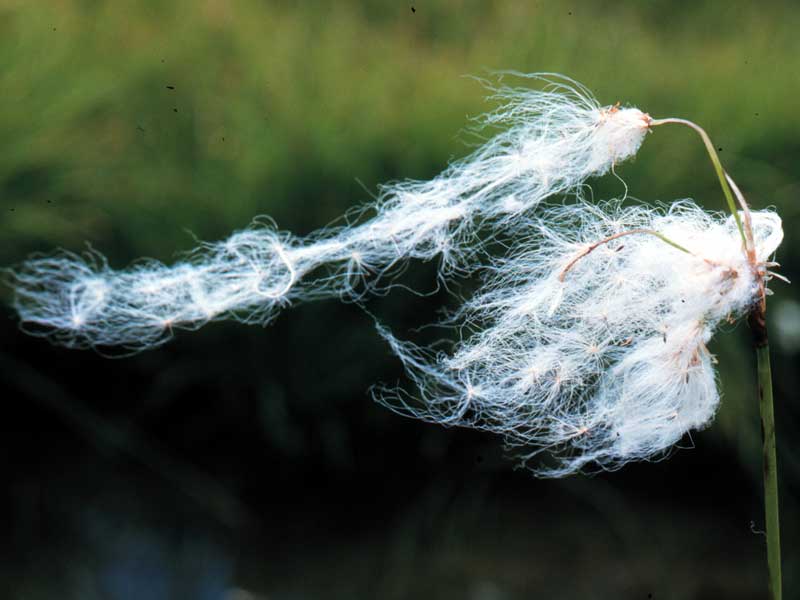Protected Area
Identity Card
- Land Surface Area: 82.74 ha
- Lower altitude (m): 1'063
- Higher altitude (m): 1'249
- Regions: Piemonte
- Provinces: Torino
- Municipalities: Oulx
- Establishment Measures: LR 19 29/06/2009
- PA Official List: EUAP0888
- Park Authority: Città Metropolitana di Torino
Stagno di Oulx Special Nature Reserve of Provincial Interest
Stagno di Oulx Reserve covers a small area between the 1,063 and the
1,249m of altitude, in the Municipality of Oulx, in upper Susa Valley.
The
naturalistic interest of Stagno di Oulx area was already evinced in
"Flora Segusina" by Giovanni Battista Re in 1805, where it was
mentioned as a station rich in rare species; thanks to two works by
Gian Paolo Mondino in 1963 and 1974 in which he thoroughly analyzed the
floristic aspects of the area, Stagno di Oulx has been inserted into a
first list of areas of naturalistic interest for its richness in rare
species for Susa Valley and the whole western Alpine Chain. This list
was published by Società Botanica Italiana with the title
"Censimento dei biotopi di rilevante interesse vegetazionale meritevoli
di conservazione" ("Census of biotopes of considerable vegetational
interest deserving conservation"). Among the most interesting species,
Mondino mentions Epipactis palustris, Molinia coerulea, Schoenus ferrugineus, Salix repens, Allium scodoprasum, Rhamnus frangula.
Stagno di Oulx derives from the filling up of a quarry used to extract
the necessary clay for the bricks to build the Frejus Tunnel (1861 -
1871). Afterwards, the basin was used to produce ice; the ice produced
by Salbertrand icehouse met the demand of great part of middle and
lower Susa Valley. The icehouse was abandoned in the 30s, as well as
agricultural practice and grass mowing; the Lake has slowly filled up
and has naturally evolved until it became a pond surrounded by large
canebrakes consisting of Phragmites australis, peat bogs and hygrophilous meadows dominated by the presence of Carex and Eriophorum.
The forest vegetation is characterized by woodland stretches of Scots
Pine with mesophile broad-leaf trees; in the undergrowth willows,
viburnums, and Prunus padus grow.
The Fauna of Borello Lake
The fauna populating Borello Lake reserve is characteristic of the forests of the mountain environment.
The main animals we can find here are:
- Red Deer (Cervus elaphus): Artiodactyla order, belonging to the Cervidae family, with a reddish-brown summer coat becoming grayish in winter; it feeds on grass, berries, buds, and bark. It can be found in woodlands and pastures, and in spring and autumn it reaches low altitudes, also near town centers; during the summer, it prefers to go even beyond the arboreal limit. The herds are formed by females and calves, while stags carry a solitary life and join the herd only in autumn, during the mating season. During the rut, the woodlands resound with their roars, with which each stag signals its presence both to females and rivals, with which they engage in fierce fights. After 33-34 weeks of gestation, towards the end of May, the calf is born (rarely there are twin calves) with the characteristic white spotted coat.
- Common Kingfisher (Alcedo atthis): it belongs to the Alcedinidae family. It has a long and strong bill at the base, short wings and tail, and small legs. In the upper parts it is bright metallic blue, in the lower parts and the cheeks rust yellow, on the sides of the chin it has a white spot. The flight of the kingfisher is rapid and uniform. It lives near lakes and ponds and prefers small woods and bushes growing along clear watercourses. It mainly feeds on small fish and crabs, and several insects, above all for the chicks. It fishes only with the bill, suddenly dropping with a splash from a branch or a rock.
- Wolf (Canis lupus): it has long legs and large paws, and a great resistance. Smell is its most developed sense, 100 times more developed than the human one. The winter fur is long and thick, with a gray color; on the contrary, during the summer it is short, thin, and reddish-brown. It has a white spot extending on the sides of the snout and the cheeks, while the top of the tail is black. It is a very social animal living in groups, whose size depends on the environment and whose organization follows a strict hierarchy, essential to guarantee the success of the pack, for instance when hunting very big preys. Only the alpha male and female reproduce, but all the members of the group actively take part in breeding and defending the pups.
- Vagrant Darter (Sympetrum vulgatum): dragonfly with a brown chest and black legs with yellow stripes, and a small yellow spot at the base of each wing. It is a very rare species, populating above all lentic waters above the 1,000 meters of altitude.
- Grass Snake (Natrix natrix): it has a typically dark green or brown color with drawings. It has a characteristic orange, yellow, or white collar. It is a day reptile, harmless for man, but if disturbed it may let out a high-pitched whistle and strike without actually opening its mouth. It rarely bites. When it is seized, it produces a foul-smelling fluid from the anal glands. It hibernates. It swims well and enters the water to hunt its preys (fish, frogs, amphibians): after feeling their movements through the soil vibrations, it swallows the preys while they are still alive.
- The canals surrounding Stagno di Oulx are characterized by the presence of the very rare invertebrate Austropotamobius pallipes: the European freshwater crayfish. This invertebrate seems to prefer the stagnant waters at the base of Cotolivier. Its ideal habitat is represented by fresh and high-quality mountain watercourses, not very turbulent, rich in oxygen and with temperatures of no more than 20-22 °C. The ideal pH goes from pH 7 to pH 8. For the formation of the exoskeleton, the presence of a specific concentration of calcium salts is very important. Given its rarity, it has been inserted by IUCN in the red list of Invertebrates and in the list of the Habitat Directive protected species.
Flora and Vegetation
In 1979 Società Botanica Italiana inserted Borello Lake in
"Censimento dei biotopi di interesse vegetazionale meritevoli di
conservazione in Italia" ("Census of biotopes of considerable
vegetational interest deserving conservation in Italy"). In 1995 Regione Piemonte,
in order to recognize its great naturalistic value, included it in the
list of Sites of Community Importance established by the European Union
Habitat Directive (1992), aiming at protecting those places housing
rare and endangered animal and vegetable species. Moreover, the Province
established a real Special Nature Reserve enabling a more efficient
safeguard of the vulnerable environmental systems characterizing the
peat bog and the lake, providing at the same time ecocompatible
visiting opportunities.
After the establishment of the Reserve, the
lake - whose size is similar to the size of 4 football fields - has
been colonized by plants and animals typical of the wetlands. Among the
stems of the canebrakes surrounding the stretch of water there are now
vegetable species that is difficult to find elsewhere in the Alps, like a
small orchid with white flowers, the purple moor grass, the sand leek,
the brown bog-rush. The surrounding woodland consisting of birches and
scots pines has been enriched by glossy buckthorns and creeping
willows. The scots pinewood has covered the areas hit by the stream
floods, while where the vegetation is thinner, Artostaphylus uva ursi and Hippophae rhamnoides grow with no rival sciaphilus plants - that is plants avoiding the
light and preferring shady areas. In other areas, the alder mixes with
the scots pine and the shrubby stratum is dominated by formations
consisting of Lonicera xilosteum, Crataegus monogyna, Ligustrum vulgare, Viburnum lantana and Rosa rubiginosa.
The alder wood dominates in the wettest stations, where there is no
drainage and soils have a thin structure; in these areas the shrub
stratum is very thick, with species like the almost exclusive Viburnum and Prunus padus.
The high humidity and shadow produced by the alder and the thick shrubs
of the undergrowth exclude the pine from these stretches of land.
The
canebrake, sometimes intruding, exclusively grows in the area around
the lake and limits rarer rival species. For this reason, we try to
favor it by eliminating the canebrakes. Moreover, the meadow
associations in the valley bottom and on the slopes are characterized
by species which well adapt to dry conditions, while they become
dominating as the meadow cultivations get abandoned.
After a research by Prof. Mondino, Stagno di Oulx was included in 1974 into a first list of areas of naturalistic interest for the richness in rare species for Susa Valley and the whole western Alpine Chain. Among the others:
- Epipactis palustris, an orchid which has been defined rare in the Alps by Pignatti in his "Flora d'Italia". For its autoecological features, it prefers wet grasslands and the marshes in the mountains and hills, and cool soils with a basic pH
- Frangula alnus, deciduous shrub belonging to the Rhamnacee family, mainly growing in wet environments and on the edges of the forest formations or in the hedges surrounding the canals
- Molinia coerulea, heliophilous species living on sandy soils or peat bogs or also hydromorphous soils, poor in bases
- Allium scorodoprasum, belonging to the Alliaceae family and preferring dry draining soils, it is rapidly reducing because of agricultural practices
- Salix repens, creeping willow typical of mountain peat bogs, extremely specialized on very wet soils. Rare to find in the Alps, it has found around Lago Borello a suitable station
- Schoenus ferrugineus, growing in the marshes and in low peat bogs, extremely rare in Valle di Susa.













